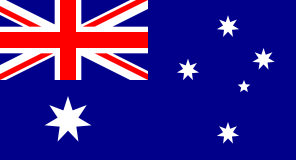Australia
Green hydrogen vision
Australia has set a vision for itself to become a global leader with its clean, innovative, safe, and competitive hydrogen industry. The country is looking to send a clear message to trading partners about Australian commitment to developing a future marketplace for hydrogen and hydrogen-based fuels. Australia hopes to boost its annual domestic production capacity to over 1 million tonnes of green hydrogen by 2030.
Focusing on large-scale export and manufacturing industries will help bring down the cost of producing renewable hydrogen in Australia. It will also support the national emissions reduction goals. Hydrogen is expected to play a role in decarbonising existing hard-to-abate sectors such as long-haul transport and aviation. It could also potentially support power generation. Australian hydrogen could avoid emissions of between 93 and 186 million tonnes of CO2 per year by 2050.
National Strategy
Bolstering this green vision is Australia’s 2024 National Hydrogen Strategy, released in September of the same year, aimed at positioning the country as a global renewable hydrogen leader. The new strategy thoroughly reviews the country’s 2019 hydrogen strategy. It has identified four objectives across supply, demand, community benefit and trade, supported by 34 actions. The objectives are as follows:
-
Making sure Australia’s hydrogen industry is globally cost-competitive.
-
Identifying and supporting the most prospective hydrogen demand sectors.
-
Ensuring communities are aware of and realise the benefits of hydrogen.
-
Establishing trade at scale and leverage purposeful partnerships.
Australia has already announced a globally significant project pipeline of more than 100 projects since 2019. The IEA reports that 20% of all announced projects globally are in Australia. This pipeline is more extensive than any other single country. It represents approximately half of all export-oriented projects announced globally. The pipeline is growing yearly. It is currently valued at $225 billion or more. The pipeline is overwhelmingly focused on renewable hydrogen production, as Australia’s extensive wind and solar resources provide the foundation for producing low-cost renewable hydrogen.
However, most projects remain at the feasibility or engineering stage. Many other countries also have excellent renewable resources. The 2024 National Hydrogen Strategy is tailored to the development of an Australian industry. It accepts that Australia must actively compete with other nations to be considered a global hydrogen leader.
Capacity and capacity targets
At the core of efforts to scale up Australia’s hydrogen industry are the green Hydrogen Production Tax Incentive programme and the expanded green Hydrogen Headstart initiative. These production incentives were announced as part of the government’s Future Made in Australia plan through the 2024/2025 federal budget.
The two programmes are expected to take Australia’s annual domestic production capacity to over 1 million tonnes of green hydrogen by 2030. Ultimately, Australia will target producing at least 15 million tonnes of hydrogen annually by 2050.
The strategy also includes a base export target of 0.2 million tonnes of renewable hydrogen per year for 2030. Furthermore, Australia’s green hydrogen production could reach an electrolyser capacity of nearly 50 GW by 2030.
Impact Targets
Hydrogen has many potential applications, but the strategy currently focuses on the most prospective use cases. These demand sectors are more likely to support the hydrogen sector in scaling up, contributing to domestic decarbonisation, and contributing to our economy through large-scale exports.
- Green metals (iron & alumina): Global demand for green iron and steel is forecast to grow significantly by 2050. Hydrogen can provide a clean source of industrial process heat for refining mineral resources and enable the export of hydrogen-embodied green metals, such as iron and alumina.
- Ammonia: Clean hydrogen is the only viable pathway to decarbonising current ammonia production, essential to manufacture fertilisers and explosives. Ammonia also represents a viable means of transporting hydrogen to other countries and will be a fuel in the decarbonising maritime industry.
- Long haul transport (heavy road, aviation, shipping): There are good prospects for hydrogen to play a role directly or indirectly by producing low-carbon liquid fuels in decarbonising the long-haul road, aviation and shipping sectors.
- Power generation & grid support: Internationally, Australian hydrogen can help other countries reduce emissions from their power sectors and achieve energy security goals. Domestically, the ability to produce hydrogen with excess renewable generation and store this energy for peak demand also presents an opportunity for hydrogen to support the increased use of renewables in our electricity grids.
Policy Spotlight
In March 2021, Hyundai, ENGV, ActewAGL, The Australian Capital Territory (ACT) Government and renewable energy developer Neoen Australia collaborated to open and operate Australia’s first public hydrogen refuelling station. The station was designed and built by Pacific Energy, and the station was then acquired by Pacific Energy in April 2024– it produces and stores hydrogen on-site and can currently refuel up to 30 vehicles with plans for expansion in place. Transport is the largest source of emissions in the ACT, contributing over 60% of all greenhouse gas emissions. Opportunities for hydrogen to support emissions reduction from transport, especially for commercial fleet operators, are present in the ACT owing to its small footprint and road links to NSW and Victoria.
Financing
The government of Australia announced in May 2024 a series of large-scale investments aimed at boosting the country’s clean energy sector, including plans to invest A$8 billion (USD$5.3 billion) in hydrogen production and technology over the next 10 years as part of its budget for 2024-25.
The Hydrogen Production Tax Incentive, at a rate of AUD 2 per kg of eligible hydrogen produced, will form the basis of government support to the sector till 2040.
The Australian Government announced the establishment of the $2 billion Hydrogen Headstart initiative to underwrite the most significant green hydrogen projects to be built in Australia.
Government green hydrogen lead
- Department of Industry, Innovation and Science
- COAG Energy Council Hydrogen Working Group
- Portal: Australia’s National Hydrogen Strategy
